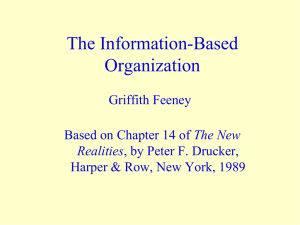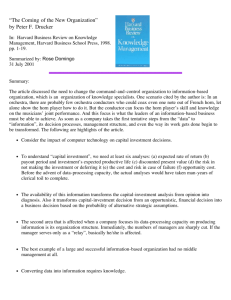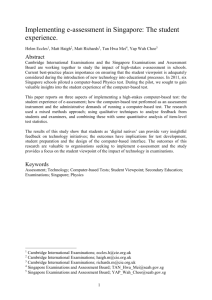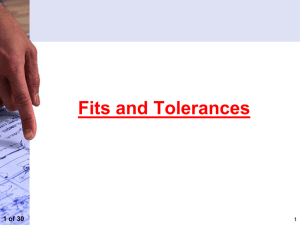Sample PowerPoint – Security Model
advertisement
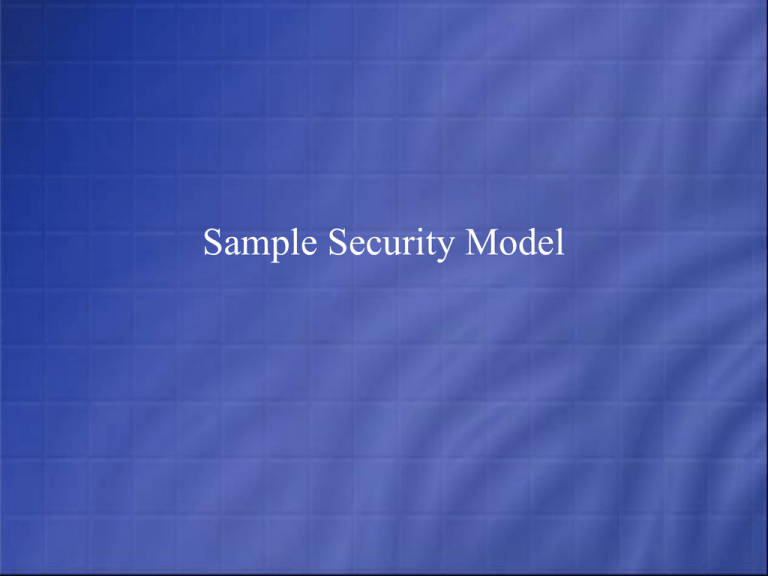
Sample Security Model Security Model Secure: Identity management & Authentication Filtering and Stateful Inspection Encryption and VPN’s Monitor: Intrusion Detection and Response Content-Based Detection and Response Employee monitoring Security Posture Assessment Vulnerability Scanning Patch verification/Application audit POLICY Manage: Secure Device Management Event / Data Analysis and Reporting Network Security Intelligence Audit Monitor Audit: Manage Secure Information Warfare Definition "Actions taken to achieve information superiority by affecting adversary information, information-based processes, information system, and computer-based networks while defending one's own information, information-based systems, information systems and computer-based systems." Information Warfare Definition(s) Information warfare is the offensive and defensive use of information and information systems to deny, exploit, corrupt, or destroy, an adversary's information, information-based processes, information systems, and computer-based networks while protecting one's own. Such actions are designed to achieve advantages over military or business adversaries.(Dr Ivan Goldman) Skill vs Technology Decreasing Skill and Knowledge and resources 1940 Increasing Tools, Power and Sophistication 2004 Outbound Open Source Business Case Implementation • Objective • Code cleanup • Launch Planning • Measuring • Metrics • License selection • Architecture • Development environment & portal • Community Awareness • Ongoing Marketing • Competitive Participation • Strategic Direction • Cost / Benefit Analysis • Community Relevance • Risk Mitigation • Training Marketing Maintenance Levels of Concern (Low, Moderate, High) Level of concern for confidentiality Based on the tolerance for unauthorized disclosure or compromise of information on the system Level of concern for integrity Based on the tolerance for unauthorized modification or destruction of information on the system Level of concern for availability Based on the tolerance for delay in the processing, transmission, or storage of information on the system or the tolerance for the disruption or denial of a service provided by the system Levels of Concern (Low, Moderate, High) Level of concern for external exposure Based on the definitions in SP 800-37 (user access methods, backend connections, number of users) Level of concern for internal exposure Based on the definitions in SP 800-37 (security background assurances/clearances, access approvals, need-to-know) Level of concern for total system exposure Based on the values assigned to both external and internal exposure factors as defined in SP 800-37 System Characterization Levels of concern for confidentiality, integrity, availability and system exposure determine: Security controls for the IT system Security certification level Classes of Security Controls Management Controls Controls that address the security management aspects of the IT system and the management of risk for the system Operational Controls Controls that address the security mechanisms primarily implemented and executed by people (as opposed to systems) Technical Controls Controls that address security mechanisms contained in and executed by the computer system A Comprehensive Approach Linking Critical Assessment Activities INFORMATION ASSURANCE (IA) Objectives of the IA Program Security Risks = (Threats x Vulnerabilities) - Countermeasures Exposure • Employ efficient and cost-effective security features to protect information system resources • Adopt a risk-based life cycle management approach • Conduct an assessment of threats, identify and apply appropriate safeguards Objectives of the IA Program (Continued) Protect the information with regard to: Confidentiality Integrity Availability Authentication Non-repudiation What is the threat? • Internal – Intentional (Disgruntled Employee) – Unintentional (Employee Error) • External – Intentional (Terrorists, Hackers) – Unintentional (Natural Disaster) IA Program Personnel • • • • • • Designated Approving Authority (DAA) Information Systems Security Manager (ISSM) Network Security Officer (NSO) Information Systems Coordinator (ISC) Information Systems Security Coordinator (ISSC) YOU YOUR Responsibilities • • • • • Computer & Network Security Information Security Software Security Physical Security Communications & Emanations Security • Personnel / Administration Security YOUR Responsibilities Computer & Network Security • Log-On Information • Warning Banner • Use of Corporate Systems YOUR Responsibilities Computer & Network Security P A S S W LOGOFF R D YOUR Responsibilities Computer & Network Security • System Configuration Information • Virus Detection • Firewalls YOUR Responsibilities Information Security • Classification level of information • Back-ups • Off-Site Storage • Media Protection YOUR Responsibilities Software Security • DO NOT install unapproved software • Software Accountability / Inventory • Software Copyright YOUR Responsibilities Physical Security • DRMO/Destruction • Housekeeping • Media Protection • Ensure adequate physical controls YOUR Responsibilities Communications & Emanations Security • Sending Sensitive data over the Internet • Encryption • TEMPEST YOUR Responsibilities Personnel & Administration Security • Operating Procedures • Training • System Accreditation • Incident Reporting • Need-to-know • Audit Trails • Contingency Planning • Adequate Environmental Controls SUMMARY • We must incorporate a security mindset in our day-today operations • You are the most important asset in the fight to provide adequate security of our Information Systems
